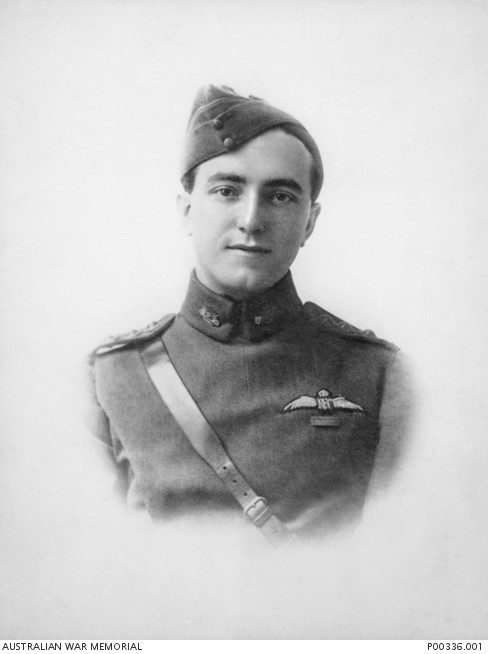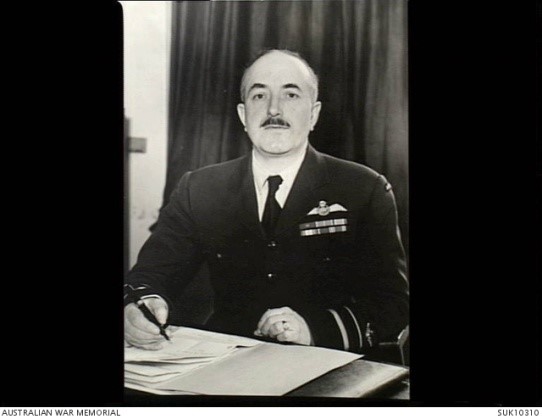 Lieutenant (later Air Commodore and Air Vice Marshal) Frank Hubert (Francis) McNamara was born in Rushworth, northern Victoria on April 4, 1894. He trained as a teacher and taught at various schools. He had also joined the cadets while at school. At the outbreak of World War 1, he performed garrison duty before being trained at the Officers’ Training School in Broadmeadows in December 1914, where after completing his course, he instructed others. He was chosen in August 1915 for the Point Cook Flying School, graduating as a pilot in October. In January 1916 he sailed to Egypt but went on to England where he did further training and service before returning as an instructor to Egypt rejoining his original No 1 Australian Flying Corps Squadron.
Lieutenant (later Air Commodore and Air Vice Marshal) Frank Hubert (Francis) McNamara was born in Rushworth, northern Victoria on April 4, 1894. He trained as a teacher and taught at various schools. He had also joined the cadets while at school. At the outbreak of World War 1, he performed garrison duty before being trained at the Officers’ Training School in Broadmeadows in December 1914, where after completing his course, he instructed others. He was chosen in August 1915 for the Point Cook Flying School, graduating as a pilot in October. In January 1916 he sailed to Egypt but went on to England where he did further training and service before returning as an instructor to Egypt rejoining his original No 1 Australian Flying Corps Squadron.
The British and Australian Air Force was attacking a Turkish supply centre near Gaza in March 1917. As part of a raid on March 20, he was one of four aircraft dropping bombs. He dispatched three of his four weapons successfully but the 4th exploded prematurely injuring his thigh. As he began to return to base,  he spotted a colleague, Captain David Rutherford, who had crash landed, standing beside his plane with Turkish cavalry approaching. Despite his wound, he landed his plane near Rutherford who climbed onto the wind and hung on to the struts. McNamara attempted to take off but the weight was unbalanced and with his severe injury, he could not control the plane and it overturned. The two injured men set fire to the plane then scrambled back to Rutherford’s plane. While Rutherford repaired the engine, McNamara used his revolved to shoot at the Turkish cavalry. Meanwhile, the other two pilots overhead also joined in the fight to ward off the enemy. They got the engine started and McNamara managed to take off successfully and fly the damaged plane, 70 miles (113km) back to base at El Arish, despite heavily bleeding from his leg. He passed out shortly after from pain and blood loss and was taken to hospital where he almost died from an allergic reaction to a routine injection. After artificial respiration he recovered. His heroic and selfless act saved the life of Rutherford.
he spotted a colleague, Captain David Rutherford, who had crash landed, standing beside his plane with Turkish cavalry approaching. Despite his wound, he landed his plane near Rutherford who climbed onto the wind and hung on to the struts. McNamara attempted to take off but the weight was unbalanced and with his severe injury, he could not control the plane and it overturned. The two injured men set fire to the plane then scrambled back to Rutherford’s plane. While Rutherford repaired the engine, McNamara used his revolved to shoot at the Turkish cavalry. Meanwhile, the other two pilots overhead also joined in the fight to ward off the enemy. They got the engine started and McNamara managed to take off successfully and fly the damaged plane, 70 miles (113km) back to base at El Arish, despite heavily bleeding from his leg. He passed out shortly after from pain and blood loss and was taken to hospital where he almost died from an allergic reaction to a routine injection. After artificial respiration he recovered. His heroic and selfless act saved the life of Rutherford.
For his gallantry, he was awarded a Victoria Cross – the first and only one to an Australian airman in World War 1 and the only VC given to anyone in the Middle Eastern campaign.
 He was promoted to Captain on April 10, but his wound prevented him from flying and he was sent back to Australia in August 1917. He was discharged from the army in January 1918 but was soon recalled when the German raider “Wolf” was discovered in Australian waters. He did aerial reconnaissance and was a flying instructor for the rest of World War 1. Between the wars he served with the newly formed Royal Australian Air Force and also returned to England serving with the RAF on exchange duty. During World War II he served as Air Officer Commanding the British Forces in Aden (Yemen) before again representing Australia as the RAAF’s representative at the British Ministry of Defence. In 1946 he was appointed Director of Education at the headquarters of the British Occupation Administration in Germany. He died in London on Nov 2 1961.
He was promoted to Captain on April 10, but his wound prevented him from flying and he was sent back to Australia in August 1917. He was discharged from the army in January 1918 but was soon recalled when the German raider “Wolf” was discovered in Australian waters. He did aerial reconnaissance and was a flying instructor for the rest of World War 1. Between the wars he served with the newly formed Royal Australian Air Force and also returned to England serving with the RAF on exchange duty. During World War II he served as Air Officer Commanding the British Forces in Aden (Yemen) before again representing Australia as the RAAF’s representative at the British Ministry of Defence. In 1946 he was appointed Director of Education at the headquarters of the British Occupation Administration in Germany. He died in London on Nov 2 1961.
He was described by his colleagues as a quiet, unassuming, courteous, cheerful man beloved by all.
References:
https://www.awm.gov.au/people/P10676512/
http://adb.anu.edu.au/biography/mcnamara-frank-hubert-francis-7430
https://en.wikipedia.org/wiki/Frank_McNamara_(VC)
Pictures:
- Australian War Memorial https://www.awm.gov.au/collection/P00336.001
- 1. Frank McNamara – Honisett, Ray, Air Vice-Marshal Frank McNamara, oil on canvas. Australian War Memorial, ART29094
- Australian War Memorial https://www.awm.gov.au/collection/SUK10310/

